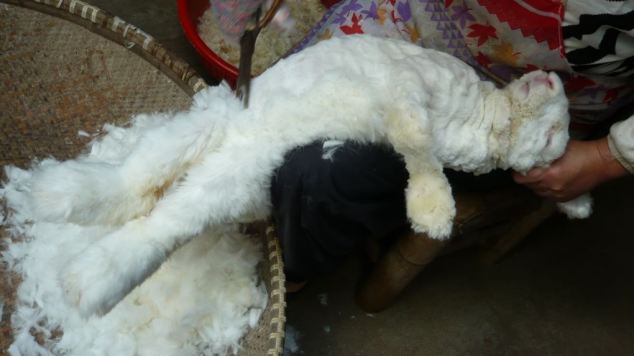Rabbit fur: face the facts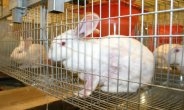
The killing of rabbits for their fur is the fastest growing part of the global fur trade, yet little is known about it. 50 million animals are slaughtered worldwide each year for their fur but this figure does not even include rabbits as accurate figures are hard to come by.
Around the world most systems of animal factory farming - such as battery hen cages, foie gras production, mink fur farming - have been the subject of detailed scientific studies, campaigns by animal rights groups and even government bans. Meanwhile, the factory farming of rabbits for their fur and flesh has received little attention .... until now.
The Coalition to Abolish the Fur Trade (CAFT) have infiltrated and exposed this hideous trade. A trade where millions of rabbits are confined to bare wire cages, kept as breeding machines, their throats slit and their furs turned into boots, hats, gloves and trim for jackets.
Travelling across Europe, infiltrating rabbit farms, slaughterhouses, processors, manufacturers and retailers, CAFT can now expose the reality of the rabbit fur trade.
Rabbits
Rabbits are social animals who, in the wild, live in large groups and build complex warrens to live in. There's nothing more rabbits like to do than play, run, jump and groom one another. They are intelligent creatures and can live up to 10 years old. But for the millions of rabbits to be killed for someone's vanity and palate, life couldn't be any more different...
There are two main breeds in the commercial rabbit farming industry: Rex and New Zealand White (or California White). The Rex is bred specifically for her fur and white rabbits have traditionally been bred primarily for meat. There is also another breed, the Orylag, bred for both meat and fur, farmed only in France.
All breeds are kept in a battery style system of bare wire mesh cages, with little space to move, never mind stretch out, play, hop or even sit fully upright. In some cases, caged rabbits can develop deformations of the spine.
Cages for single rabbits, such as those bred for their fur, have the floor space of about two shoeboxes. Cages with groups of up to 12 rabbits may only be a third larger.
Mothers are kept separated from their kits and only allowed into the nursing area to feed them. Whilst the mothers would nurse the kits infrequently in the wild, the fact that she is not in control of when she can nurse her babies will cause stress. When the mother is under stress she may also eat her young.
Rex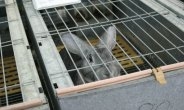
There are two breeds of Rex bred for fur: Castor Rex (a brown colour) and Chinchilla Rex (which is the same colour as chinchilla and is sometimes used as a cheaper alternative to expensive chinchilla fur).
Taken from their mothers at 4 weeks old, the rabbits are then caged with siblings for another 3 - 4 weeks before spending the next 6 - 7 months in solitary cages to prevent fighting and damaging the pelt. They are killed after shedding their first winter coat, when the fur is much thicker.
Breeding animals are kept for up to 3 years and the mothers are re-bred from 1-3 weeks after giving birth and will usually give birth twice a year.
White
rabbits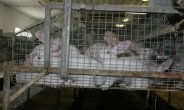
The New Zealand or California White rabbit has traditionally been bred for their meat. They are kept with their mothers to around 4 - 5 weeks old, then moved with siblings to a fattening cage, where they will stay until 10 - 12 weeks old when killed.
The primary focus of farming this breed has always been for meat and slaughterhouses often threw the fur away. In recent years an increase in the demand for cheap rabbit fur has led to more slaughterhouses selling the pelts.
Orylag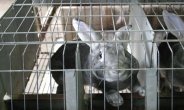
Orylag rabbits are only bred on 20 farms in France, having been genetically manipulated and developed by the French National Institute for Agricultural Research (INRA). The farmers have to work in line with the policies of the Orylag co-operative, which has a €3million annual turnover and deals with designers such as Fendi, Dior, Channel, Hermes, D&G, amongst others.
60% of the profits from Orylag rabbits comes from their fur and 40% from the meat and this is considered to be the future of rabbit farming.
The mother will usually have around seven young, but as many as 12. She is re-mated a few days later by artificial insemination. Her babies will stay with her until 4 weeks old, then moved into cages with their siblings until 7 weeks old then moved into single cages to prevent fighting.
The rabbits are killed at 20 weeks of age and this takes place throughout the year rather than at one set time.
Deaths
Mortality rates are high for both Rex and white rabbits - usually between 10 - 15%. Mortality for Orylag rabbits is 25 - 30%. The farms account for this loss without affecting their profit margin. This is a far higher mortality rate than in other commercial animal farming. The rabbits mostly die from respiratory disease.
Transport to slaughter
It is very common for rabbits to die en route to slaughter and rates as high as 7 or 8% have been reported [1]. This is often due to the way the rabbits are tightly packed in; viruses can be easily spread and poor ventilation causes respiratory failure. Broken bones and traumatic lesions are also common, due to bad handling.
Slaughter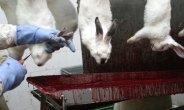
Slaughter methods observed by CAFT investigators at European rabbit farms varied. Some animals were killed on the farm by being hit over the back of the head with a heavy stick before having their throats slit. Commercial slaughterhouses stunned the rabbits with electrical devices and again slit their throats.
At one slaughterhouse filmed by CAFT, at which 9,000 rabbits were killed each day, rabbits were held in crates piled eight high in view of those being slaughtered. Covered in faeces and urine from rabbits in crates above them, some were clearly still alive as they bled to death.
Welfare concerns
Rabbits are bred in bare wire cages, creating both physical and behavioural problems.
The mesh flooring of the cages causes damage to the feet of the rabbit and this can result in sore hocks (ulcerative pododermatitis), leading to infections and abscesses. Research carried out in 2004 found that up to 15% of does suffered from sore hocks [2] and up to 40% had paw injuries that were sufficiently serious for them to show signs of discomfort [3].
The
stench of ammonia from the urine soaked floors, which tends to overpower any
other odour in a commercial rabbit unit, can irritate the eyes of the rabbits
and lead to painful infections.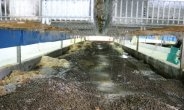
The housing of the rabbits, both separately and as a group, causes problems. Since rabbits are social animals, being separated from another rabbit causes immense stress and this social deprivation leads to stereotyped behaviour such as gnawing on cage bars (a common behaviour exhibited by caged animals) and over-grooming (repetitively plucking one's own fur is a form of self-mutilation). Even group housing of adolescent sibling rabbits is no better. The overcrowding of the cages leads to increased aggression and fighting. Fur-plucking and ear-biting are behavioural manifestations attributed to overcrowding.
Bare cages means boredom, which again leads to stereotyped behaviour. Most research carried out on whether rabbits benefit from cage enrichment proved that any kind of enrichment, such as gnawing sticks or even just hay, was a positive step in reducing boredom, cage gnawing and fighting. Even though this is widely accepted, none of the farms visited by CAFT had any enrichment.
These animals will never experience fresh air or natural sunlight - until they are taken for slaughter!
Manufacturing
Traditionally, rabbit fur products have only used the pelts of rabbits bred
specifically for their fur as this is of a higher quality. Skins of rabbits
killed for their meat at 10 - 12 weeks is not of good quality and many
slaughterhouses still throw these away. But an increasing demand for rabbit fur,
particularly from China, means that the fur of white rabbits, bred for meat, is
now more often used.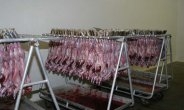
Manufacturing companies can make cheap fur more appealing through a variety of processes such as dying, shaving and making patterns. Many of these companies have now moved to China to exploit low wages and avoid environmental regulations. The processed pelts are often sent back to Europe to be made into garments.
Farmers of rabbits for meat told CAFT investigators that the price paid for the meat has not increased for several years, remaining a stable price. Now that some farmers can get between 10 - 45 cents for each pelt, this has no doubt allowed many to continue caging rabbits in these appalling conditions when they may have otherwise closed.
Increased use of rabbit fur
There is a consensus within the rabbit farming industry that the increased use of rabbit fur is due to the cheap production which allows them to experiment freely with processes such as dying that would be less likely with more expensive fur. Being able to experiment with rabbit furs has meant that designers feel more confident to do this now with other furs.
High quality rabbit fur comes from those animals bred primarily for their fur. Although cheaper fur products may come from those rabbits bred primarily for their meat, this is by no means a by-product. The additional profits from the sale of the pelt is the only thing keeping some farms in business.
Whether a rabbit killed for her flesh also has her fur used to trim a jacket or make a pair of gloves is irrelevant. Anyone consuming rabbit meat is still funding the barbaric and unnecessary caging, deprivation and slaughter of animals.
The rabbit mother who has her babies taken away from her at four weeks is not concerned about why all this happens to her and her young, only that it does happen. She is not concerned about whether her babies are turned into a pair of gloves or somebody's dinner; she is just concerned that her babies are taken away from her and that she is imprisoned in a cage that doesn't allow her to do all that comes naturally to a rabbit - to feel the sun on her back, to run and hop.
SPEAK OUT AGAINST THE CRUEL FUR INDUSTRY
BOYCOTT STORES SELLING FUR
DON'T BUY FUR EVEN IF IT’S LABELLED FAUX. YOU JUST DON’T KNOW AND IT SENDS THE WRONG MESSAGE!
November 20, 2013 Cruel truths of the angora fur trade revealed in shocking footage which shows rabbits having hair PULLED out... because the traders make more money
December 15, 2013 British stores suspend orders for super fluffy angora wool products after horrifying video reveals cruel techniques used to skin the rabbits
Comment: A most vile industry. The human species is totally ruthless, capable of unimaginable atrocities. But there are many who care. Please join forces with us and help stamp out this evil. PETA has just announced a victory - Calvin Klein and Tommy Hilfiger—and all other retailers owned by PVH Corp.—are banning and pulling from their shelves any products made with angora!
October 21, 2015 Free People gives up angora after PETA protest
Comment: It’s public pressure and boycotts that force companies to reassess business practices. If there’s enough negative publicity and the bottom line is impacted, these otherwise immoral and inhumane corporations will respond accordingly.
Read more: Dying for fur - inside China's fur farms
May 11, 2015 Canada exports more furry animals than automobiles to China.
In 2014 Canada recorded $160.7 million in exports of “fur-bearing animal and rabbit production” to China, one of the fastest growing countries in the world, compared to $158.5 million worth in “automobile and light-duty motor vehicle manufacturing.” We’re not knocking rabbit farmers, but one industry employs 117,000 people, the other, not so much.
Full article http://www.macleans.ca/economy/economicanalysis/5-depressing-facts-about-canadas-exports/2021: Cities and countries that have banned fur farming and fur sales. http://www.humanedecisions.com/cities-and-countries-that-have-banned-fur-farming-and-fur-sales/
June 20, 2022 The Decline of Fur Farming in Canada We Animals Media In many countries around the world, markets for fur are closing down as demand wanes. This year, on February 9, 2022, the first-ever national Bill to ban fur farms was introduced in Canada (Bill C-247).
Animal Rights Groups Taking action for the voiceless. Be part of the movement!
The cruelty and torture inflicted upon defenseless animals is an aberration of justice and a violation of the innocent at its core.

